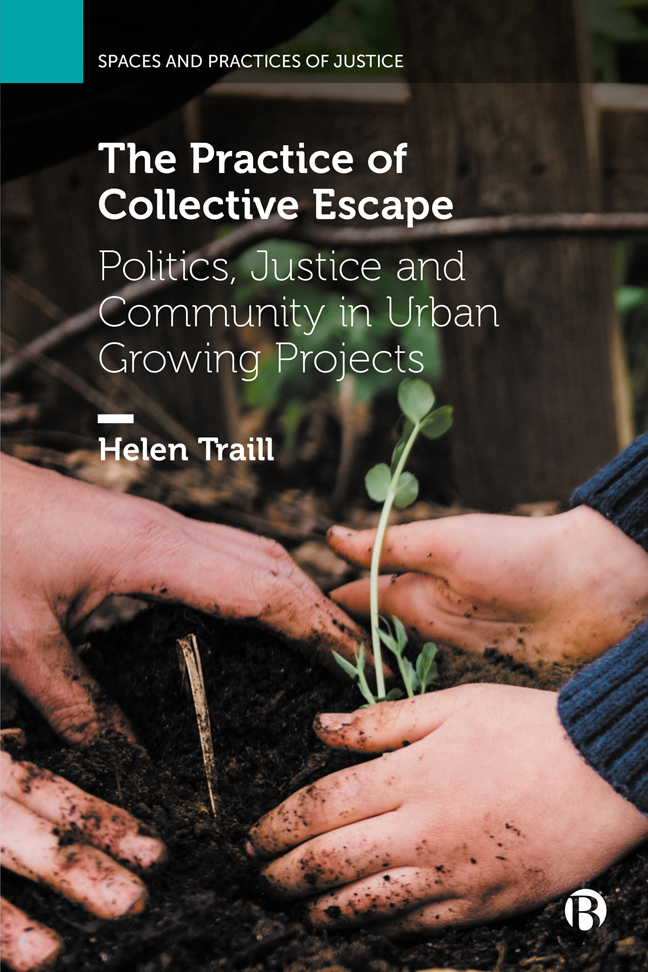Book contents
- Frontmatter
- Dedication
- Contents
- Series Preface
- Acknowledgements
- 1 Introduction
- 2 Urban Growing in Glasgow
- 3 The Rhythms of Urban Escape
- 4 Who Gets to Escape?
- 5 Ownership, Autonomy and the Commons
- 6 Escape into Responsibility
- 7 Field Dynamics and Strategic Neutrality
- 8 The Political Imagination of Common Justice
- 9 Escape, Crisis and Social Change
- 10 Conclusion
- Notes
- References
- Index
9 - Escape, Crisis and Social Change
Published online by Cambridge University Press: 23 January 2024
- Frontmatter
- Dedication
- Contents
- Series Preface
- Acknowledgements
- 1 Introduction
- 2 Urban Growing in Glasgow
- 3 The Rhythms of Urban Escape
- 4 Who Gets to Escape?
- 5 Ownership, Autonomy and the Commons
- 6 Escape into Responsibility
- 7 Field Dynamics and Strategic Neutrality
- 8 The Political Imagination of Common Justice
- 9 Escape, Crisis and Social Change
- 10 Conclusion
- Notes
- References
- Index
Summary
Communal growing projects over time
Time emerges as a critical element in understanding the evolution and implications of communal growing practices. Projects react to opportunities within funding structures and the broader social landscape, adapting and filling spaces that emerge. This is most clearly demonstrated by attending to continuities and crises that have emerged since the initial in-depth fieldwork of 2015–16. Reflecting on the enduring problems of communal growing projects, I argue that a longer temporal lens is required to understand communal growing projects as emerging in context over time. This allows for a deeper engagement with the question of how communal growing projects might become more transformative, more political, over time and what conditions facilitate this.
Naturally, attending to the period between 2016 and 2022 requires some reflections on the COVID-19 pandemic. Both case studies had social value during the height of the COVID-19 crisis because of what they already were – spaces of release, of decompression, of time sovereignty and of collective meaning. That is, because they were spaces of escape. This longer-term basis is important to recognize, against a prevailing narrative around interconnection and mutual aid as suddenly emerging. The quick praise for mutual aid and solidarity that emerged during the pandemic overlooks perhaps the slow burn of social connection that we are always already enmeshed in (Studdert and Walkerdine, 2016b, 2016a; Blokland, 2017; Care Collective, 2020) and which is a crucial element of what makes the social infrastructure of cities function. Underplayed too within narratives of mutual aid's explosion is the important collective imaginary underpinning such work – and underpinning the work of the community gardens here. The idea of community, of collective life, of mutual support is critical (see Chapter 6 and Traill, 2021). Moving from the extremely local to the global, the lenses of tragedy and crisis demonstrate how the key analytical themes of the ethnographic fieldwork echo, morph and survive through tragedy and crisis, reflecting the broader significance of spaces of everyday escape.
Many of the most acute critiques around justice and politics in the growing projects studied here take on a different hue when viewed with a little extra hindsight. In returning to the projects again across the years between 2016 and 2022, changes emerged which shed new light on growing as a situated phenomenon.
- Type
- Chapter
- Information
- The Practice of Collective EscapePolitics, Justice and Community in Urban Growing Projects, pp. 139 - 149Publisher: Bristol University PressPrint publication year: 2023

